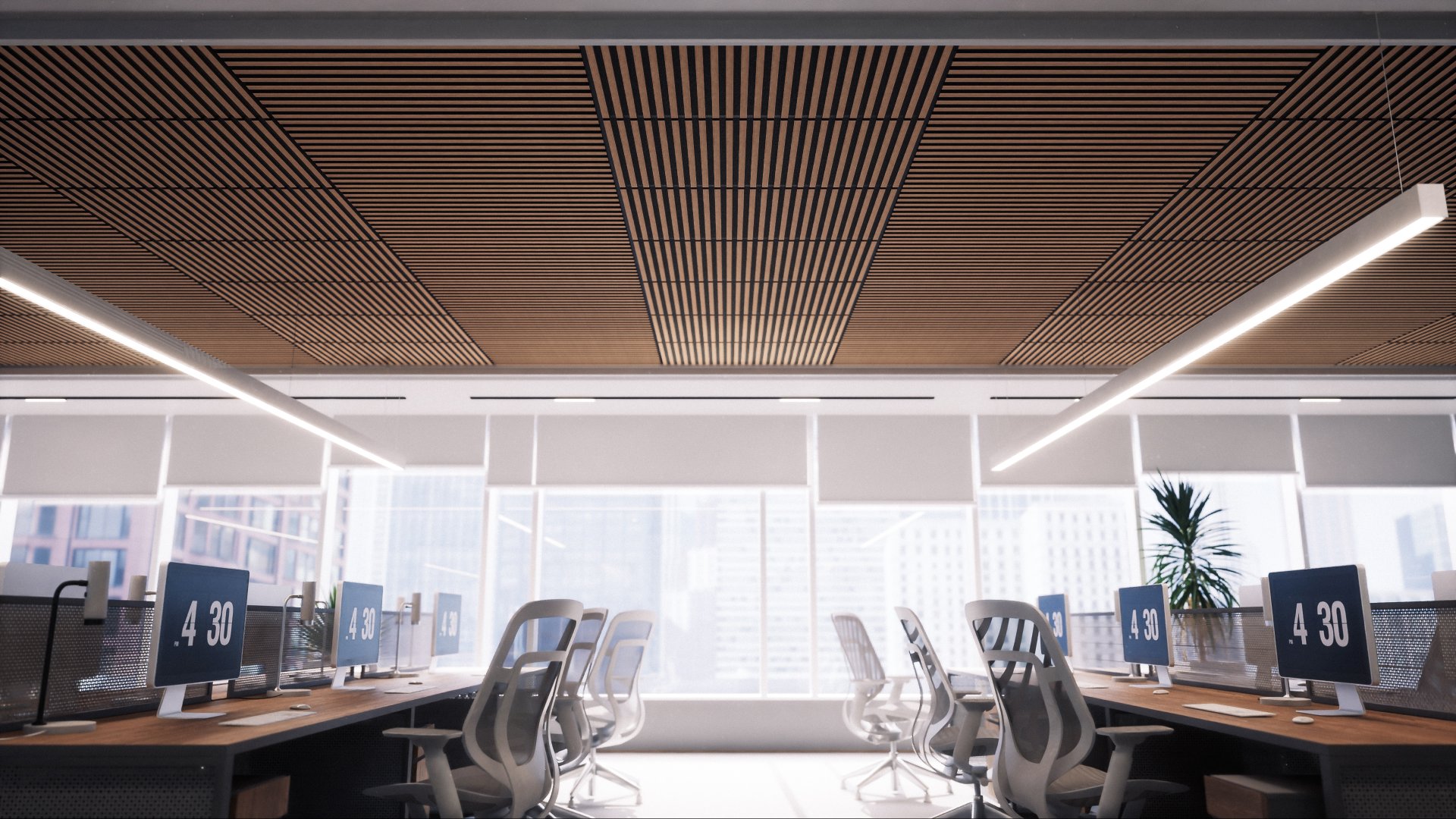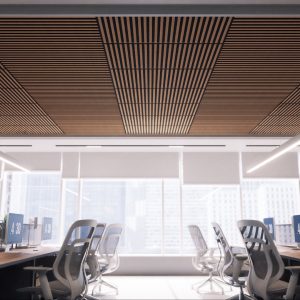There is a wide world of building materials available today. Choosing the right ones can improve our homes and offices in more ways than one might expect. Incorporating wood slat panels into interior designs is a wonderful way of adding both contemporary elegance and improved acoustics to any space. They may look like expensive additions, but they are surprisingly affordable. Let’s look at what wood slat panels are, as well as some of the ways builders are creating wood slat design trends that focus on contemporary architectural acoustics.
What are Wood Slat Panels?
Wood slat panels are decorative panels that are made of strips of wood, spaced out in parallel or patterned layouts. They add the warm and natural look of wood that enhances the visual appeal of any space, but also deliver the added benefit of helping to improve acoustics through both sound absorption and diffusion. These benefits are provided by the makeup of the panels themselves. Wood is a naturally ideal surface when it comes to acoustics. That’s because it is both porous and reflective at the same time. This mix creates the perfect combination to deliver room sound that is neither too loud or too soft. Plus, the spaces between the slats allow for some sound diffusion that breaks up reflections and makes the acoustics sound more balanced and natural. For all these reasons, wood slat panels and wood slat ceiling systems make the perfect contemporary solution for acoustical treatments in rooms where sound really matters.
Modern Applications of Wood Slat Panels
Many people associate acoustical treatments with recording studios, and that’s about it. While it is true that sound studios rely heavily on acoustical treatments, there are a lot of spaces we might not think of that rely upon sound control. Let’s take a look at some of the spaces where wood slat panels can be used to tremendous effect.
Commercial Spaces
Many more commercial spaces rely on acoustical treatments than we might think, from live performance venues to medical facilities. Here are some places savvy business owners use acoustic wood in modern interiors to enhance their offerings.
Medical Facilities
One of the most important things a medical facility can do is keep your confidential information private. One way they accomplish this is through the use of acoustical treatments. Introducing absorptive materials and diffusers keeps conversations where they belong by reducing reflections that cause echo and reverberation. Installing wood slat panels in waiting rooms delivers a warm look while helping to keep conversations private.
Restaurants and Cafes
A great restaurant is a feast for all the senses. Even if the food is wonderful, a loud room can ruin the mood and take away from the overall experience. Keep the sound under control with wood slat panels. They are available in a wide range of wood species and custom wood slat patterns to match any design scheme to provide a high end aesthetic for eateries of all types.
Office Spaces
Acoustic wood in office design can have big impacts on your bottom line and the health of your employees. That’s because chronic exposure to noise can negatively impact our ability to concentrate, which may lead to missed deadlines and lowered productivity. Noise exposure can also elevate stress levels, leading to hearing loss and other serious health problems. Choosing warm, contemporary wall coverings that help with noise reduction is a great step for employee health and happiness.
Educational Facilities
Like office spaces, lecture halls and classrooms in universities are places where we must be able to concentrate and focus on our work. When spaces here get too noisy, they can negatively impact the learning environment. Wood slat panels are a great-looking solution to acoustical issues.
Live Performance Venues
Any place that relies on high end aesthetics and acoustical performance to match can benefit from wood slat panels, and few spaces fit that bill quite as nicely as live performance venues. Spaces like orchestra halls, opera halls, and other performing arts centers benefit from both the form and the function of wood slat panels due to the natural ability of these wood strips to provide both.
Residential Settings
There are spaces in the home that can benefit from wood slat applications too. Their natural ability to enhance both the aesthetics and the acoustics in any space can be utilized perfectly in a few different rooms within homes. Notably, the living room and any theaters or media rooms.
Living Rooms
As one of the biggest gathering spots in most homes, living rooms require a solid mix of aesthetic appeal and great sound in order to provide a warm and inviting spot for our friends and family to socialize. Utilizing residential acoustic wood panels in the interior decorating scheme provides both. Wood is a classic home building material that looks and sounds great. Choosing wood slats over alternatives like tongue and groove or planks provides enough sound diffusion to eliminate echo and keep reverberation to a minimum. This improves speech intelligibility and makes for a nicer overall experience.
Theaters and Media Rooms
Theaters and media rooms require great sound in order to impress. Installing wood acoustic panels here will make your media room look and sound like a real theater. If you’re going to spend the money on high end electronics to represent your music and movies the way the creators intended, it’s important that you optimize the space to make the most of them.
Comparing Acoustic Wall Treatment Options
There are a number of decorative elements that provide acoustic benefits. Not all of them are created equally, so it’s helpful to see how wood slat panels stack up against the competition. For a comprehensive acoustic panel comparison, we will cover four of the most popular alternatives on the market.
Wood Slat vs Fabric Acoustic Panels
Fabric-wrapped acoustic panels are some of the most popular acoustical treatments available today. They can be printed to fit any interior decorating scheme, and they do a wonderful job of absorbing mid and high frequency sounds. However, these panels are not meant to cover entire surfaces like walls or ceilings. Covering these surfaces with wood slat panels and accenting them with fabric-wrapped panels will deliver amazing results.
Wood Slat vs PET Felt Panels
PET felt panels are a relatively new acoustical treatment product that has taken the market by storm in recent years. PET, short for polyethylene terephthalate, is a plastic material primarily made from recycled beverage bottles. PET felt is a wonderfully sustainable material, delivers the look of traditional felt in a wide range of color options, and is easy to maintain. Plus, it’s great at absorbing sound waves. PET felt panels have a lot going for them, but the look is very different from that of wood slat panels. Where wood slats deliver a warm, natural look, PET felt delivers a modern splash of color that’s often more eye-popping than subtle. While PET felt ceiling tiles and panels are great acoustical accents to the space, wood slat panels are a much better solution when covering entire walls.
Wood Slat vs Microperforated Aluminum Panels
Another incredibly effective option when it comes to acoustical wall treatments are microperforated aluminum panels. They are pierced with hundreds of tiny holes each, which allow some of the sound waves to pass through the panels. This takes some of the reflections that could otherwise create acoustical issues out of the equation. Microperforated panels can be finished with printed wood grains to provide the look of real wood, and they are great for covering entire walls and ceiling systems. However, they do not provide the same sound diffusion that acoustic wood slat panels do. They also don’t create the kind of texture we get with wood slats.
Wood Slat Panels are Eco-Friendly Acoustics Solutions
Depending on their material specifications and the context in which they are used, these panels may qualify for LEED (Leadership in Energy and Environmental Design) credits. LEED certification is available in a range of different categories. If the materials meet at least one of the following criteria, there is a good chance you will qualify for credits.
- The wood is sourced from sustainably managed forests
- The panels incorporate recycled materials
- The panels are finished with low-VOC (volatile organic compounds) products
- The panels contribute to an overall acoustic design that enhances the quality of indoor environments
- The panels contribute to overall energy efficiency or sustainability goals
This is not an exhaustive list. If you would like to learn more about LEED credits for choosing sustainable acoustic solutions, consult with a professional for further advice.
Installing Wood Slat Panels
One of the biggest benefits of wood slat panels is that they can be installed fairly easily. In fact, if you have a few basic tools, you may even be able to tackle the wood slat installation yourself, saving you a considerable amount of money. You’ll just want to make sure you take a few items into consideration before you begin.
- Step 1: Make sure you select the right panels for your project. Let your supplier know if you are planning to install them in humid areas or high impact locations to make sure you get panels that will stand up to the environment.
- Step 2: Decide on your arrangement before you begin hanging panels. Consider both how you want them to look and how you want them to perform acoustically. If you need help, your supplier should be able to offer some advice.
- Step 3: Make sure the surfaces where you will mount them are clean, dry, and flat. If there are any imperfections, make sure to repair them before you hang your panels.
- Step 4: If the wall is not suitable for mounting your panels, create a framework with furring strips. This will provide a more suitable surface for mounting.
- Step 5: Be aware of any lighting integrations before cutting. It is okay to use sconces or other wall lighting with wood slat panels, but it’s easier to prepare them at the initial cutting stage.
Maintaining Wood Slat Panels
Regular wood slat panel maintenance is going to be required if you want to keep your panels looking and functioning great for the long haul. If the room is prone to humidity, make sure you take measures to keep the humidity in check. If the panels come into contact with moisture, make sure to wipe them dry immediately.
Also, make sure to dust and spot clean them periodically with a non-abrasive, lint-free cloth or microfiber duster. Use a light application of a gentle cleanser made for wood where needed. If you see any damage during cleaning, be sure to address it before the damage gets any worse.
Finally, make sure to protect your wood slat panels from direct light and heat to make sure they keep their appearance. Following these simple steps will ensure your panels look fantastic for many years to come.




